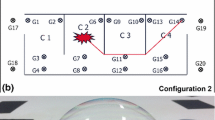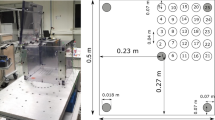Abstract
The behavior of a shock wave generated by a hemispherical gaseous charge and propagating within a confined multi-chamber system is analyzed through the evolution of some of the shock parameters (maximum overpressure and positive impulse). The influence of a variation in the volume of the rooms on the pressure history inside the building is also studied. Several small-scale experiments have been carried out using an adjustable model representative of a pyrotechnic workshop. The experimental results show that the pressure histories are very complex. Yet, using a global approach, we were able to link the evolution of the arrival time of the shock wave within the building with the reference obtained in the free field. New parameters were developed to best fit the experimental maximal overpressure in the cells and in the corridor leading to two predictive laws used to estimate the maximal overpressure in the model.














































Similar content being viewed by others
References
U.S. Department of the Army, Fundamentals of protective design for conventional weapons, Technical Manual 5–855 (1986)
U.S. Department of the Army, Structures to resist the effects of accidental explosions, Technical Manual 5–1300 (1990)
Kinney, G.F.: Explosive Shocks in Air. MacMillan, London (1962)
Schelinski-Glück, G.: Blast Propagation in Tunnels behind Chambers from Cylindrical H.E-Charges Detonation in the Tunnel Entrance, \(13^{\rm th}\) Int. Symp. on Military Aspects of Blast and Simulation, The Hague, The Netherlands (1993)
Ripley, R.C., Von Rosen, B., Ritzel, D.V., Whitehouse, D.R.: Small-scale modeling of explosive blasts in urban scenarios. In: \(21^{\rm st}\) International Symposium on Ballistics, Adelaide, Australia (2004)
Reichenbach, H., Neuwald, P.: Fluid Dynamics of Explosion in Multi-chamber Systems Phenomenology Test Program, Defense Threat Reduction Agency Technical Report \(\text{ n }^{\circ }\) ADA 384351 (2000)
Reichenbach, H., Neuwald, P., Kuhl, A.L.: Role of Precision Laboratory Experiments in the Understanding of Large-Scale Blast Phenomena, Julius J. Meszaros Lecture, \(17^{\rm th}\) Int. Symp. on Military Aspect of Blast and Shock, Las Vegas, Nevada, USA (2002)
Sauvan, P.E., Sochet, I., Trélat, S.: Analysis of reflected blast wave pressure profiles in a confined room. Shock Waves 22, 253–264 (2012)
Julien, B., Sochet, I., Vaillant, T.: Explosion in a multi-chamber: Experimental investigation, \(22^{\rm nd}\) Int. Symp. on Military Aspect of Blast and Shock, Bourges, France (2012)
Trélat, S., Sochet, I., Autrusson, B., Loiseau, O., Cheval, K.: Strong explosion near a parallelepipedic structure. Shock Waves 16, 349–357 (2007)
Mainiero, R., Sapko, M.: Blast and Fire Propagation in Underground Facilities, Defense Nuclear Agency technical report, contract n\(^{\circ }\) DNA JACRO-93-862, DNA-TR-93-159 (1996)
Sinha, N., Crawford, B.G., Ott, J.D.: High fidelity simulations of complex multi-room target defeat using energetic explosives, 21 Int. Symp. on Military Aspect of Blast and Shock, Jerusalem, Israel (2010)
Kogarko, S.M., Adushkin, V.V., Lyamin, A.G.: Investigation of spherical detonation of gas mixtures. Fiz. Goreniya i Vzryva 1, 22–34 (1965)
Rose, T.A., Smith, P.D.: Oblique Clearing : Blasts Loads on Buildings at Non-Zero Angles of Incidence, \(18^{\rm th}\) Int. Symp. on Military Aspect of Blast and Shock, Bad Reichenhall, Germany (2004)
Gitterman, Y.: Air-blast analysis and secondary shock features for large-scale surface chemical explosions at Sayarim Military Range, Israel, \(22^{\rm nd}\) Int. Symp. on Military Aspect of Blast and Shock, Bourges, France (2012)
Joachim, C.E., Lunderman, C.V.: Parameter study of underground ammunition storage magazines: result of explosion tests in small-scale models, Technical Report n\(^{\circ }\) ADA 500131 (1994)
Acknowledgments
This work was funded by DGA Techniques Terrestres under Contract No. 10-02-0288A.
Author information
Authors and Affiliations
Corresponding author
Additional information
Communicated by F. Zhang and A. Higgins.
Rights and permissions
About this article
Cite this article
Julien, B., Sochet, I. & Vaillant, T. Impact of the volume of rooms on shock wave propagation within a multi-chamber system. Shock Waves 26, 87–108 (2016). https://doi.org/10.1007/s00193-015-0603-2
Received:
Revised:
Accepted:
Published:
Issue Date:
DOI: https://doi.org/10.1007/s00193-015-0603-2




